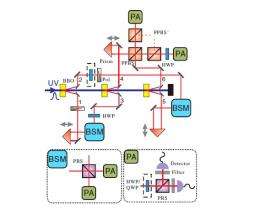December 8, 2010 feature
Physicists demonstrate teleportation-based optical quantum entangling gate

(PhysOrg.com) -- Taking a step toward the realization of futuristic quantum technologies, a team of physicists from China and Germany has demonstrated a key element – an entangling gate – of a quantum teleportation scheme proposed more than 10 years ago. The entangling gate serves as a fundamental building block for applications such as long-distance quantum communication and practical quantum computers.
The scientists, Wei-Bo Gao, Jian-Wei Pan, and coauthors from the University of Science and Technology of China in Hefei, Anhui, China, and the University of Heidelberg in Heidelberg, Germany, have published their study in an early edition of the Proceedings of the National Academy of Sciences.
The work builds on earlier research by D. Gottesman and I. L. Chuang, who theoretically showed in 1999 that a quantum gate can be built by teleporting qubits (the basic units of quantum information) with the help of certain entangled states. In quantum teleportation techniques, unknown quantum states are transferred from one location to another through the use of entanglement. One of the key requirements of the "GC scheme" is the ability to perform single-qubit logic operations for quantum computations.
In the new study, Gao, Pan, and coauthors have experimentally demonstrated the feasibility of the GC scheme by demonstrating a logic gate based on quantum teleportation for two photonic qubits. Further, the scientists demonstrated the entangling gate using two different methods – one with a six-photon interferometer to realize controlled-NOT gates, and the other with four-photon hyperentanglement to realize controlled-Phase gates.
“The logic gate is the basic unit in a quantum computer, as a classical logic gate is in a classical computer,” coauthor Yu-Ao Chen of the University of Science and Technology of China told PhysOrg.com. “The difference with the quantum logic gate is that it involves quantum superposition. The controlled-NOT gate, together with single-qubit operations, is sufficient to perform all logic operations needed for quantum computation. In classical computation, it is similar, and it can be easily achieved by measurement and feedforward. However, in the quantum world, the states cannot be measured directly without irrevocably changing them. This makes the demonstration of a CNOT gate more difficult.”
In their study, the scientists showed how each of the two methods could be used to entangle qubits, transfer qubit states, and enable quantum logic operations. The researchers also confirmed that both logic gates demonstrate genuine entanglement, and showed that the controlled-Phase gate achieves quantum parallelism, meaning that the gate cannot be reproduced by local operations and classical communications.
While the experiments here represent an important step toward the realization of practical quantum computers, there are still many other components to work on in order to develop an advanced optical system in the future. As the scientists explained, one of the advantages of the current scheme is that it is inherently fault-tolerant.
“Our experiment shows a proof-of-principle that the GC scheme can be implemented to construct a linear optical computational hierarchy,” Chen said. “The GC scheme is a protocol that could potentially be implemented in a real-world optical quantum computer because it is inherently fault-tolerant, which is a very basic request for any large-scale computation protocol.”
As Chen noted, some of the potential applications of quantum computing include the efficient simulation of complex quantum physics, chemistry systems, or materials systems; the ability to quickly solve certain mathematical problems; and database searching.
More information: Wei-Bo Gao, et al. “Teleportation-based realization of an optical quantum two-qubit entangling gate.” PNAS Early Edition. DOI:10.1073/pnas.1005720107
Copyright 2010 PhysOrg.com.
All rights reserved. This material may not be published, broadcast, rewritten or redistributed in whole or part without the express written permission of PhysOrg.com.

















